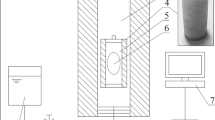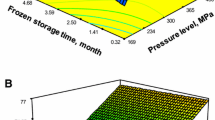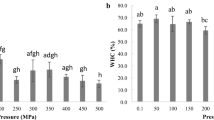Abstract
Effect of high pressure in inducing textural and functional modification has been investigated in pink perch (Nemipterus japonicus) mince. Fish mince undergone pressurization at 200, 400 and 600 MPa for a holding period of 10 min and was compared against cooked mince (90 °C; 40 min). The treated mince at 400 and 600 MPa lost its natural viscosity and behaved like cooked mince through denaturation and formation of protein aggregates. Textural characterisation showed the retention of tenderness in 200 MPa treated samples, but become harder on application of higher pressures. Unlike heat gels, pressure induced gels were more smooth, white and elastic in nature. A decreased in reactive SH groups was observed in 400 and 600 MPa treated samples due to the formation of disulfide bonds. Hydrophobic concentration was higher in cooked and 600 MPa treatments whereas Ca2+−ATPase activity decreased after pressurization. On application of different pressures microbial reduction of 2–3 log cycles was achieved in the mince samples. Hence pressure treatments at lower ranges cannot alter the texture and functionality of protein and the mince can undergo processing as required. Besides extending shelf life, the treatments above 400 MPa can make irreversible effect on texture quality and protein functionality which is similar to that of cooking.





Similar content being viewed by others
References
Angsupanich K, Ledward DA (1998) High pressure treatment effects on cod (Gadus morhua) muscle. J Food Chem 63(1):39–50
AOAC 2016. Official Methods of Analysis of AOAC International. 990.12. Aerobic plate count in foods (17.2.07), Chapter 17 pp 12.
Ashie INA, Lanier TC (1999) High pressure effects on gelation of surimi and turkey breast muscle enhanced by microbial transglutaminase. J Food Sci 64:704–708
Bajovic B, Bolumar T, Heinz V (2012) Quality considerations with high pressure processing of fresh and value-added meat products. Meat Sci 92:280–289
Barbosa-Canovas GV, Pothakamury UR, Palou E, Swanson BG (1997) Nonthermal preservation of foods. Marcel Dekker, New York
Bindu J, & Das S 2018. High-pressure applications for preservation of fish and fishery products. *Research Methodology in Food Sciences: Integrated Theory and Practice*, 341.
Bindu J, Ginson J, Kamalakanth CK, Asha KK, Gopal TKS (2013) Physico-chemical changes in high pressure treated Indian white prawn (Fenneropenaeus indicus) during chill storage. Innov Food Sci Emerg Technol 17:37–42
Binsi PK, Shamasundar BA, Dileep AO (2007) Physico-chemical and functional properties of proteins from green mussel (Perna viridis) during ice storage. J Sci Food Agric 87(2):245–254
Bolumar T, Orlien V, Sikes A, Aganovic K, Bak K, Guyon C, Stübler A-S, Lamballerie M, Hertel C, Brüggemann D (2020) High-pressure processing of meat: molecular impacts and industrial applications. Comprehensive Rev Food Sci Food Safety. https://doi.org/10.1111/1541-4337.12670
Bourne MC (1978) Texture profile analysis. Food Technol 32:62–72
Cao Y, Xia T, Zhou G, Xu X (2012) The mechanism of high pressure-induced gels of rabbit myosin. Innov Food Sci Emerg Technol 16(39):41–46
Cheftel JC, Culioli J (1997) Effects of high pressure on meat: a review. Meat Sci 46:211–234
Chelh I, Gatellier P, Sante-Lhoutellier V (2006) Technical note: A simplified procedure for myofibril hydrophobicity determination. Meat Sci 74(4):681–683
Chen X, Chen CG, Zhou YZ, Li P, Ma F, Nishiumi T (2014) Effects of high pressure processing on the thermal gelling properties of chicken breast myosin containing κ-carrageenan. Food Hydrocolloids 40:262–272
Farr D (1990) High pressure technology in the food industry. Trends Food Sci Technol 1:14–16
Gekko K, Koga S (1983) The effect of pressure on thermal stability and in vitro 16 fibril formation collagen. Agric Biol Chem 47:1027–1033
Georget E, Sevenich R, Reineke K, Mathys A, Heinz V, Callanan M, Knorr D (2015) Inactivation of microorganisms by high isostatic pressure processing in complex matrices: a review. Innov Food Sci Emerg Technol 27:1–14
Guo M, Liu S, Ismail M, Farid MM, Ji H, Mao W et al (2017) Changes in the myosin secondary structure and shrimp surimi gel strength induced by dense phase carbon dioxide. Food Chem 227:219–226
Heremans K, Goossens K, Smeller L (1996) Pressure-tuning spectroscopy of proteins Fourier transform infrared studies in the diamond anvil cell. In: Markley JL, Northtrop DB, Royer CA (eds) High-pressure effects in molecular biophysics and enzymology. Oxford University Press, New York
Hugas M, Garriga M, Monfort JM (2002) New mild technologies in meat processing: high pressure as a model technology. Meat Science. 62:3
Hunter RS, Harold RW (1987) The measure of appearance. Willey Interscience, New York
Jaczynski J, Park JW (2004) Physicochemical changes in Alaska pollock surimi and surimi gel as affected by electron beam. JFS: Food Chem Toxicol 69(1):53–57
Jiménez Colmenero F (2002) Muscle protein gelation by combined use of high pressure/temperature. Trends Food Sci Technol 13:22–30
Jiménez Colmenero F, Fernández P, Carballo J, Fernández-Martín F (1998) High-pressure-cooked low-fat pork and chicken batters as affected by salt level and cooking temperature. J Food Sci 63:656–659
Jung S, Tonello-Samson C (2018) High hydrostatic pressure food processing: potential and limitations. In: Proctor A (ed) Alternatives to conventional food processing, 2nd edn. The Royal Society of Chemistry, London, pp 251–315
Karthikeyan M, Dileep AO, Shamasundar BA (2006) Effect of water washing on the functional and rheological properties of proteins from threadfin bream (Nemipterus japonicus) meat. Int J Food Sci Technol 41(9):1002–1010
Ko WC (1996) Effect of high pressure on gelation of meat paste and inactivation of actomyosin Ca-ATPase prepared from Milkfish. Fisheries Sci 62:101–104
Ko W-C, Jao C-L, Hwang J-S, Hsu KC (2006) Effect of high-pressure treatment on processing quality of tilapia meat fillets. J Food Eng 77(4):1007–1011
Lau MH, Turek EJ (2007) Determination of quality difference in low-acid foods sterilized by high pressure versus retorting. In: Doona CJ, Feeherry FE (eds) High pressure processing of foods. Blackwell Publishing
Liu H, Xu Y, Zu S, Wu X, Shi A, Zhang J, Wang Q, He N (2021) Effects of high hydrostatic pressure on the conformational structure and gel properties of myofibrillar protein and meat quality: a review. Foods 10:1872. https://doi.org/10.3390/foods10081872
Messens W, Van Camp J, Huyghebaert A (1997) The use of high pressure to modify the functionality of food proteins. Trend Food Sci Technol 8:107–112
Nakai S, Li-Chan E (1988) Hydrophobic interactions in food systems. CRC Press
Noguchi S, Matsumoto JJ (1970) Studies on the control of the denaturation of the fish muscle proteins during frozen storage. I. Preventive effect of sodium glutamate. Bull SosSci Fish 36:1078–1087
Ohshima T, Ushio H, Koizumi C (1993) High pressure processing of fish and fish -products. Trends Food Sci Technol 4(11):370–375
Ojagh SM, Nunez-Flores R, Lopez-Caballero ME, Montero MP, Gomez-Guillen MC (2011) Lessening of high-pressure-induced changes in Atlantic salmon muscle by the combined use of a fish gelatin–lignin film. Food Chem 125(2):595–606
Quali A, Valin C (1981) Effect of muscle lysosomal enzymes and calcium activated natural proteinase on myofibrillar ATPase activity: relationship with aging changes. Meat Sci 5:233–245
Ramirez-Suarez JC, Morrissey MT (2006) Effect of high pressure processing (HPP) on shelf life of albacore tuna (Thunnus alalunga) minced muscle. Innov Food Sci Emerg 7(1–2):19–27
Rastogi NK, Raghavarao KSMS, Balasubramaniam VM, Niranjan K, Knorr D (2007) Opportunities and challenges in high pressure processing of foods. Critical Reviews in Food Science and Nutrition 47(1):69–112. https://doi.org/10.1080/10408390600626420
Sarika Kunnath and Bindu Jaganath (2019) Non thermal processing of sea foods. In: Chauhan OP (ed) Non thermal processing of foods. CRC Press, pp 373–394
Sun XD, Holley RA (2011) Factors influencing gel formation by myofibrillar proteins in muscle foods. Comprehensive Rev Food Sci Food Safety 10:33–51
Suzuki A, Kim K, Tanji H, Nishiumi H, Ikeuchi Y (2006) Application of high hydrostatic pressure to meat and meat processing. In: Nollet LML, Toldra F (eds) Advanced technologies for meat processing. CRC Press, pp 194–217
Taniguchi Y, Takeda N (1996) High-pressure FTIR studies of the secondary structure of proteins. In: Markley JL, Northtrop DB, Royer CA (eds) High-pressure effects in molecular biophysics and enzymology. Oxford University Press, pp 87–95
Tausky HH, Shorr E (1952) A microcolorimetric method for the determination of inorganic phosphorus. J BiolChem 202:675–685
Taylor KDA, Himonides A, Alasalvar C (2007) 5- Increased processed flesh yield by recovery from marine by-products. In: Fereidoon S (ed) Woodhead publishing series in food science, technology and nutrition, maximizing the value of marine by products. Woodhead publishing
Torres JA, Velazquez G (2005) Commercial opportunities and research challenges in the high pressure processing of foods. J Food Eng 67:95–112
Truong BQ, Buckow R, Stathopoulos CE, Nguyen MH (2015) Advances in high-pressure processing of fish muscles. Food Eng Rev 7(2):109–129
Truong BQ, Buckow R, Nguyen MH, Stathopoulos CE (2016) High pressure processing of barramundi (Lates calcarifer) muscle before freezing: the effects on selected physicochemical properties during frozen storage. J Food Eng 169:72–78
Uriarte-Montoya MH, Santacruz-Ortega H, Cinco-Moroyoqui FJ, Rouzaud-Sandez O, Plascencia-Jatomea M, Ezquerra-Brauer JM (2011) Giant squid skin gelatin: chemical composition and biophysical characterization. Food Res Int 44:3243–3249
Venugopal V (2006) Mince and mince-based products Seafood Processing adding value through quick freezing retortable packaging cook chilling. CRC Press
Wang J, Lia Z, Zhenga B, Zhanga Y, Guo Z (2019) Effect of ultra-high pressure on the structure and gelling properties of low salt golden threadfin bream (Nemipterus virgatus) myosin. LWT Food Sci Technol 100:381–390
Zare Z 2004. High pressure processing of fresh tuna fish and its effects on Shelf Life. MSc Thesis. McGill University, Montreal, Quebec, Canada, pp. 45–76
Acknowledgements
Authors are grateful to the Indian Council of Agricultural Research for the technical and financial support. Authors also express gratitude to STIC (Sophisticated Test and Instrumentation Centre), CUSAT, Cochin for availing their instrumentation facility.
Funding
Authors express gratitute towards Indian Council of Agricultural Research for the funding.
Author information
Authors and Affiliations
Corresponding author
Ethics declarations
Conflict of interest
The authors do not any conflict of interest.
Additional information
Publisher's Note
Springer Nature remains neutral with regard to jurisdictional claims in published maps and institutional affiliations.
Rights and permissions
About this article
Cite this article
Kunnath, S., Jaganath, B., Panda, S.K. et al. Modifying textural and functional characteristics of fish (Nemipterus japonicus) mince using high pressure technology. J Food Sci Technol 59, 4122–4133 (2022). https://doi.org/10.1007/s13197-022-05466-5
Revised:
Accepted:
Published:
Issue Date:
DOI: https://doi.org/10.1007/s13197-022-05466-5




